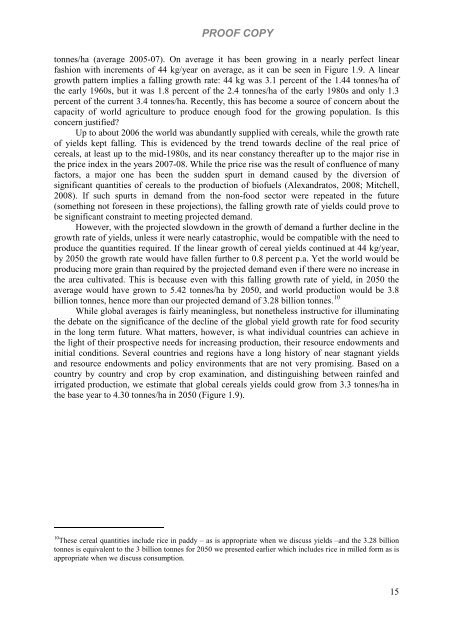World agriculture towards 2030/2050: the 2012 revision - Fao
World agriculture towards 2030/2050: the 2012 revision - Fao
World agriculture towards 2030/2050: the 2012 revision - Fao
Create successful ePaper yourself
Turn your PDF publications into a flip-book with our unique Google optimized e-Paper software.
PROOF COPY<br />
tonnes/ha (average 2005-07). On average it has been growing in a nearly perfect linear<br />
fashion with increments of 44 kg/year on average, as it can be seen in Figure 1.9. A linear<br />
growth pattern implies a falling growth rate: 44 kg was 3.1 percent of <strong>the</strong> 1.44 tonnes/ha of<br />
<strong>the</strong> early 1960s, but it was 1.8 percent of <strong>the</strong> 2.4 tonnes/ha of <strong>the</strong> early 1980s and only 1.3<br />
percent of <strong>the</strong> current 3.4 tonnes/ha. Recently, this has become a source of concern about <strong>the</strong><br />
capacity of world <strong>agriculture</strong> to produce enough food for <strong>the</strong> growing population. Is this<br />
concern justified?<br />
Up to about 2006 <strong>the</strong> world was abundantly supplied with cereals, while <strong>the</strong> growth rate<br />
of yields kept falling. This is evidenced by <strong>the</strong> trend <strong>towards</strong> decline of <strong>the</strong> real price of<br />
cereals, at least up to <strong>the</strong> mid-1980s, and its near constancy <strong>the</strong>reafter up to <strong>the</strong> major rise in<br />
<strong>the</strong> price index in <strong>the</strong> years 2007-08. While <strong>the</strong> price rise was <strong>the</strong> result of confluence of many<br />
factors, a major one has been <strong>the</strong> sudden spurt in demand caused by <strong>the</strong> diversion of<br />
significant quantities of cereals to <strong>the</strong> production of biofuels (Alexandratos, 2008; Mitchell,<br />
2008). If such spurts in demand from <strong>the</strong> non-food sector were repeated in <strong>the</strong> future<br />
(something not foreseen in <strong>the</strong>se projections), <strong>the</strong> falling growth rate of yields could prove to<br />
be significant constraint to meeting projected demand.<br />
However, with <strong>the</strong> projected slowdown in <strong>the</strong> growth of demand a fur<strong>the</strong>r decline in <strong>the</strong><br />
growth rate of yields, unless it were nearly catastrophic, would be compatible with <strong>the</strong> need to<br />
produce <strong>the</strong> quantities required. If <strong>the</strong> linear growth of cereal yields continued at 44 kg/year,<br />
by <strong>2050</strong> <strong>the</strong> growth rate would have fallen fur<strong>the</strong>r to 0.8 percent p.a. Yet <strong>the</strong> world would be<br />
producing more grain than required by <strong>the</strong> projected demand even if <strong>the</strong>re were no increase in<br />
<strong>the</strong> area cultivated. This is because even with this falling growth rate of yield, in <strong>2050</strong> <strong>the</strong><br />
average would have grown to 5.42 tonnes/ha by <strong>2050</strong>, and world production would be 3.8<br />
billion tonnes, hence more than our projected demand of 3.28 billion tonnes. 10<br />
While global averages is fairly meaningless, but none<strong>the</strong>less instructive for illuminating<br />
<strong>the</strong> debate on <strong>the</strong> significance of <strong>the</strong> decline of <strong>the</strong> global yield growth rate for food security<br />
in <strong>the</strong> long term future. What matters, however, is what individual countries can achieve in<br />
<strong>the</strong> light of <strong>the</strong>ir prospective needs for increasing production, <strong>the</strong>ir resource endowments and<br />
initial conditions. Several countries and regions have a long history of near stagnant yields<br />
and resource endowments and policy environments that are not very promising. Based on a<br />
country by country and crop by crop examination, and distinguishing between rainfed and<br />
irrigated production, we estimate that global cereals yields could grow from 3.3 tonnes/ha in<br />
<strong>the</strong> base year to 4.30 tonnes/ha in <strong>2050</strong> (Figure 1.9).<br />
10 These cereal quantities include rice in paddy – as is appropriate when we discuss yields –and <strong>the</strong> 3.28 billion<br />
tonnes is equivalent to <strong>the</strong> 3 billion tonnes for <strong>2050</strong> we presented earlier which includes rice in milled form as is<br />
appropriate when we discuss consumption.<br />
15









